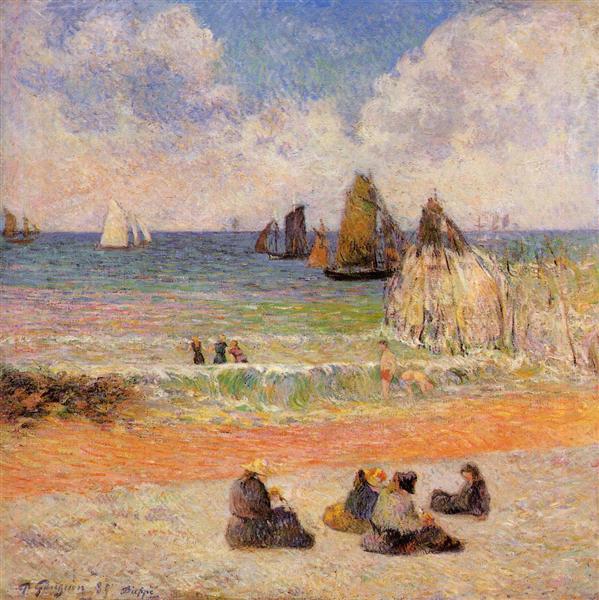Description
The painting "Bathing - Dieppe - 1885" by Paul Gauguin is a work that encapsulates the author's transition towards his characteristic style, marking an important stage in his artistic evolution. In this work, Gauguin transports us to the coast of Dieppe, where four female figures, naked and in different attitudes, are grouped into a natural environment that transcends the merely descriptive, suggesting a connection between the human being and nature.
The composition of the painting is remarkably balanced. The arrangement of the figures in space causes an immediate visual interaction. When observing carefully, we notice that women seem to merge with the environment, which highlights Gauguin's intention to explore the relationship between the individual and the landscape. The figure in the center, with a prominent position, attracts the viewer's gaze, while the other figures flank this central image, creating a sense of harmony and movement. The gestures of women, some of relaxation, and others of interaction, reflect an intimate narrative, a daily moment that invites contemplation.
As for the color palette, Gauguin uses a mixture of vibrant and terrifying tones, from the blue that evoke water to the green and brown that represent the surrounding vegetation. This color choice not only describes the scene, but also echoes its desire to transmit emotions and sensations, a distinctive feature that will characterize its work in the coming years. The shadows and lights in the work ensure a three -dimensional perception, although a simplification is perceived in the forms that are developed in their subsequent works.
Through its light and color approach, Gauguin establishes an atmosphere that invites the viewer to an almost sensory experience. You can see a subtle dialogue between the figures and their surroundings; The way in which water reflects the light, the softness of the terrain and the almost ethereal presence of women speak of a deep connection between the human being and nature, a recurring theme in Gauguin's work.
It is interesting to note that "bathe - Dieppe" was created in a period in which Gauguin began to get away from realistic painting and, on the other hand, explored a more symbolic and expressionist aesthetic. This work can anticipate the use of symbolism that Gauguin would capture more strongly in his Emblymatic works of Tahiti, where he would also address the female figure in a deeply ceremonial and cultural context.
The simplicity of the daily scene contrasts with the complex underlying emotions that Gauguin manages to evoke. In "Bathing - Dieppe - 1885", we have a work that, despite its apparent simplicity, is erected as a strong testimony of the artist's aspirations for transcending the literal representation and connecting with human emotions through the form and color. As the viewer observes this work, he can glimpse not only Gauguin's technical skills, but also his incipient search for the meaning behind everyday life, which will become central to his artistic career and that after all will define him as One of the precursors of modern art.
KUADROS ©, a famous paint on your wall.
Hand-made oil painting reproductions, with the quality of professional artists and the distinctive seal of KUADROS ©.
Reproduction service paintings With a guarantee of satisfaction. If you are not completely satisfied with the replica of your painting, we refund your money 100%.

